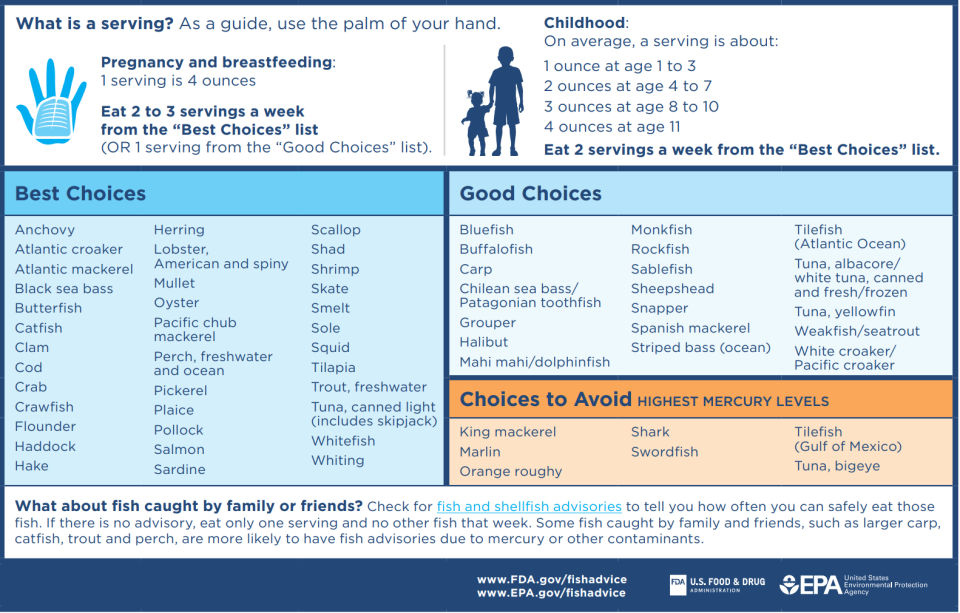EPA-FDA Advice about Eating Fish and Shellfish
For Females Who Might Become Pregnant, Are Pregnant, Are Breastfeeding, and for Children
The Food and Drug Administration and U.S. Environmental Protectional Agency have issued advice regarding eating fish and shellfish (referred to as fish from here on). This advice is for females who might become pregnant, are pregnant, or are breastfeeding as well as parents and caregivers who are feeding children. It can help people make informed choices about the types of fish that are nutritious and safe to eat.
The advice features a chart that makes it easy to choose dozens of healthy and safe options and includes information about the nutritional value of fish. A set of frequently asked questions and answers provides more information on how to use the chart and additional tips for eating fish.
This advice also supports the recommendations of the Dietary Guidelines for Americans, which reflects current science on nutrition to improve public health. The Dietary Guidelines for Americans focuses on dietary patterns and the effects of food and nutrient characteristics on health.
Fish provide key nutrients that support a child’s brain development
Fish are part of a healthy eating pattern and provide key nutrients during pregnancy, breastfeeding, and/or early childhood to support a child’s brain development:
- Omega-3 (called DHA and EPA) and omega-6 fats
- Iron
- Iodine (during pregnancy)
- Choline
Choline also supports development of the baby’s spinal cord. Fish also provide iron and zinc to support children’s immune systems. Fish are also a source of other nutrients like protein, vitamin B12, vitamin D, and selenium.
Choose a variety of fish that are lower in mercury
While it is important to limit mercury in the diets of females who are pregnant or breastfeeding and children because of its potential effect on developing brains, many types of fish are both nutritious and lower in mercury.
Figure 1 can help you choose which fish to eat and how often to eat them, based on their mercury levels.

The Dietary Guidelines for Americans recommends eating fish as part of a healthy eating pattern
The Dietary Guidelines for Americans recommends:
- At least 8 ounces of seafood (less for children†) per week based on a 2,000 calorie diet.
- Females who are pregnant or breastfeeding consume between 8 and 12 ounces per week of a variety of seafood from choices that are lower in mercury.
† For some children, the amounts of fish in the Dietary Guidelines for Americans are higher than in this FDA/EPA advice. The Dietary Guidelines for Americans states that to consume those higher amounts, children should only be fed fish from the “Best Choices” list that are even lower in mercury – these fish are anchovies, Atlantic mackerel, catfish, clams, crab, crawfish, flounder, haddock, mullet, oysters, plaice, pollock, salmon, sardines, scallops, shad, shrimp, sole, squid, tilapia, trout, and whiting.
Eating fish can provide other health benefits too
Fish intake during pregnancy is recommended because moderate scientific evidence shows it can help your baby’s cognitive development.
Strong evidence shows that eating fish, as part of a healthy eating pattern, may have heart health benefits. Healthy eating patterns that include fish may have other benefits too. Moderate scientific evidence shows that eating patterns relatively higher in fish but also in vegetables, fruits, legumes, whole grains, low- or non-fat dairy, lean meats and poultry, nuts, and unsaturated vegetable oils, and lower in red and processed meats, sugar-sweetened foods and beverages, and refined grains are associated with:
- Promotion of bone health – decreases the risk for hip fractures ‡
- Decreases in the risk of becoming overweight or obese ‡
- Decreases in the risk for colon and rectal cancers ‡
‡ There is moderate scientific evidence of a relationship between the eating pattern as a whole and the potential health benefit.
Resources and Outreach Materials
- Questions and Answers
- Social Media Toolkit
- Downloadable Advice
- Downloadable Chart (English | Spanish)
